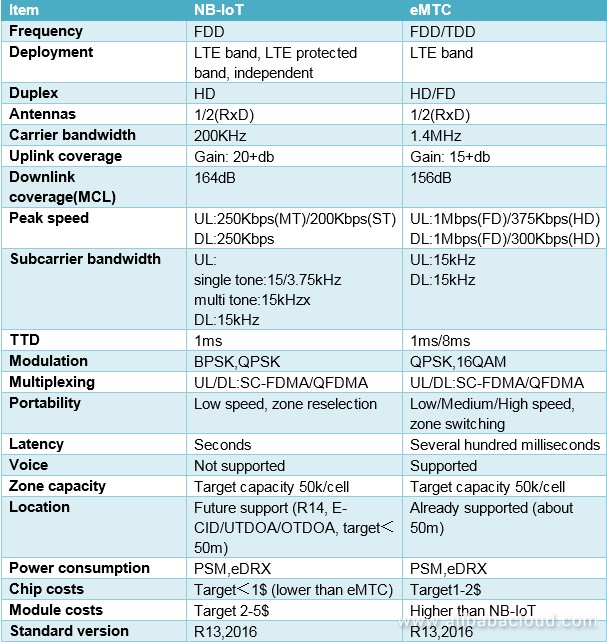For a long time, the two mobile IoT standards eMTC (enhanced machine-type communication) and NB-IoT (narrowband Internet of Things) competed, leading to an endless debate within the industry. This article analyzes the two network standards, identifying their differences on the technical level and their complementary applications. Consequently, we will be introducing the industry consensus regarding the evolution of mobile IoT technology (including NB-IoT and eMTC) as expressed by Rel. 15 of the 76th plenary meeting of the 3GPP.
As one of the most common network standards for narrowband mobile IoT, eMTC offers four major capabilities compared to non-mobile IoT systems using LPWA: wide coverage, big network, low power consumption, and low costs. Here, we will briefly discuss each of these features:
Currently, 2G terminals only have a standby time of about 20 days. In some typical LPWA applications, such as meter reading services, 2G modules obviously cannot meet the needs of terminals located in hard-to-access locations, such as deep wells and chimneys, because it is impossible to replace the batteries. In contrast, the eMTC standard consumes only 1% of the power used by a 2G modem, extending the terminal standby time to up to 10 years.
IoT terminals must connect to a massive number of users to meet the needs of "big network" applications. Currently, networks without an IoT application design do not support simultaneous access by a large volume of terminals, while eMTC can accommodate over 10,000 terminals in each zone.
Outdoor 4G base stations cannot provide full coverage, as there are blind spots in deep wells, underground parking garages, and other such locations. Concerning coverage, eMTC is 15 dB more powerful than LTE (and can penetrate multiple walls) and 11 dB more powerful than GPRS. This means its signal can reach two to three floors below ground.
Currently, smart home applications generally use WiFi for communication. Although WiFi modules do not cost much themselves (already less than 10 RMB), IoT devices that support WiFi usually also require wireless routers or wireless access points to connect to the Internet or communicate within a LAN. 2G communication modules generally cost more than 20 RMB, while 4G communication modules cost more than 150 RMB. In contrast, the cost of eMTC terminals is expected to continue to decrease due to cross-subsidization throughout the industry chain.
Compared to mobile IoT technology, eMTC uses a licensed frequency for transmission to reduce interference and provide better security. This ensures reliable transmission.
Both the eMTC and NB-IoT mobile IoT network standards have often competed and created confusion over their application scope. In fact, both standards have distinct technical advantages and can work together, so there is no better choice. As a result, the competition is decided by who can reduce their module chip costs faster, who has a higher degree of commercialization, and whose network construction is better.
This issue finally got resolved in June 2017, when the 76th plenary meeting of the 3GPP issued Rel. 15 representing a consensus on the future evolution of mobile IoT technology (including NB-IoT and eMTC). It stated that future systems with a bandwidth under 1.4 MHz would not use eMTC terminals and future systems with a bandwidth over 200 KHz would not use NB-IoT terminals.
This 3GPP resolution promotes the orderly development of M-IoT by clearly delineating the application scopes of eMTC and NB-IoT. Thus, the two standards are no longer in competition but form a hybrid network with differentiated and complementary cooperation. Now, let's compare the two standards over their technical and application aspects.
When comparing peak speeds, NB-IoT only supports data speeds under 200 Kbit/s, while eMTC can reach 1 Mbit/s. Regarding portability, because NB-IoT does not support automatic zone switching, terminals that use this standard are not portable. eMTC provides much better portability.
In terms of voice functionality, NB-IoT does not support voice transmission, while eMTC does. When it comes to terminal costs, NB-IoT's unified module and chip standard has reduced prices to around 5 USD, while eMTC prices are higher and falling more slowly.
Comparing zone capacities, we have seen that eMTC has not advanced in this direction, so it cannot satisfy the needs of high connection volume scenarios. In contrast, NB-IoT offers a coverage radius 30% larger than eMTC. eMTC's coverage is about 9 dB below NB-IoT.

Looking at the technical features of the two standards, we can see that NB-IoT offers advantages in terms coverage, power consumption, costs, and connection volume. Organizations can generally use this standard in static scenarios where lower costs, greater coverage, and longer battery life are major requirements.
Currently, eMTC is inferior to NB-IoT in terms of coverage and module costs but superior in terms of peak speed, portability, and voice capabilities. This standard is better suited for scenarios that involve voice calls, high bandwidth speed, and portable terminals. In actual use cases, the two standards can work together in a complementary manner.
As the predictive data shows, due to NB-IoT's low cost and wide coverage, the ratio of NB-IoT to eMTC connections is 8:2. However, eMTC networks support a wider range of applications that are more directly related to users, so eMTC network environments have higher ARPU values.
In the Mobile Internet of Things Industry Solutions White Paper published by China Mobile, we can see that the advent of hybrid NB-IoT/eMTC networks will increase the range of supported applications.
NB-IoT technology is effective in static scenarios, such as smart meter reading, smart switches, and smart manhole covers. However, hybrid NB-IoT/eMTC networks are suited to more interactive and collaborative IoT applications, such as full-process product management, smart parking, shared bicycles, financial leasing, cashbox monitoring, intelligent greenhouses, animal tracking, forestry data collection, remote health, smart streetlights, and smart homes. We can conclude that the synchronized promotion of NB-IoT and eMTC can meet the comprehensive IoT needs and application scenarios.
We have seen that the relationship between NB-IoT and eMTC is not an either/or choice. Rather, because NB-IoT and eMTC are suitable for different applications, operators will continue to use the two standards together, creating a larger industry chain and constantly driving increased consumption. This will provide vendors with a greater range of applications without technical restrictions and improve the experience of customers. By encouraging users to demand more, this will lay a foundation for the integrated development of 5G and various industries. This is the future path of integrated NB-IoT and eMTC development.
Find similar articles and learn more about Alibaba Cloud products and solutions at www.alibabacloud.com/blog.
From R-CNN to Faster R-CNN – The Evolution of Object Detection Technology

2,599 posts | 762 followers
FollowAlibaba Clouder - August 5, 2019
Alibaba Clouder - September 24, 2019
Alibaba Clouder - September 17, 2019
Alibaba Clouder - June 20, 2018
Alibaba Clouder - May 24, 2018
Alibaba Clouder - September 16, 2019

2,599 posts | 762 followers
FollowLearn More
 EDAS
EDAS
A PaaS platform for a variety of application deployment options and microservices solutions to help you monitor, diagnose, operate and maintain your applications
Learn More CEN
CEN
A global network for rapidly building a distributed business system and hybrid cloud to help users create a network with enterprise level-scalability and the communication capabilities of a cloud network
Learn MoreMore Posts by Alibaba Clouder